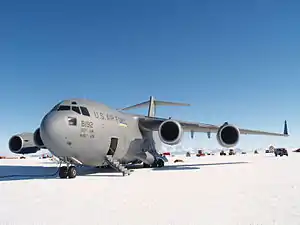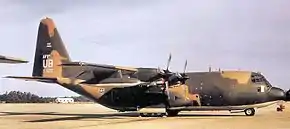304th Expeditionary Airlift Squadron
The 304th Expeditionary Airlift Squadron is a provisional United States Air Force unit. It is assigned to the 13th Air Expeditionary Group, based at Hickam Air Force Base, Hawaii.
| 304th Expeditionary Airlift Squadron | |
|---|---|
 304th EAS C-17 sits on the ice runway at McMurdo Station, Antarctica, Nov. 21, 2011. | |
| Active | 1943-1946; 1949-1951; 1952-1955; 1957-1974; 2007-Present |
| Country | United States |
| Branch | United States Air Force |
| Decorations | Distinguished Unit Citation Air Force Outstanding Unit Award Republic of Vietnam Gallantry Cross with Palm |

Mission
The 304th EAS operates the C-17 Globemaster III airlifter in support of Joint Task Force-Support Forces Antarctica (JTF-SFA). The squadron provides the bulk of the aerial resupply between New Zealand and Antarctica. It also provides intercontinental transport of personnel and cargo to and from the United States.
The 304th EAS consists of aircraft and personnel deployed forward to New Zealand from the 62d and 446th Airlift Wings, Joint Base Lewis-McChord, Washington.
History
The squadron was first activated as the 304th Troop Carrier Squadron in September 1943 under I Troop Carrier Command and equipped with Douglas C-47 Skytrains. It trained in various parts of the eastern United States until early 1944. The squadron deployed to England and became part of IX Troop Carrier Command.
The unit prepared for the invasion of Nazi-occupied Europe. It began operations by dropping paratroops of the 101st Airborne Division in Normandy on D-Day on 6 June 1944 and releasing gliders with reinforcements on the following day. The unit received a Distinguished Unit Citation and a French citation for these missions. After the Normandy invasion the squadron ferried supplies in the United Kingdom.
After moving to France in September, the unit dropped paratroops of the 82nd Airborne Division near Nijmegen and towed gliders carrying reinforcements during Operation Market Garden. the airborne attack on the Netherlands. In December, it participated in the Battle of the Bulge by releasing gliders with supplies for the 101st Airborne Division near Bastogne.
When the Allies made the air assault across the Rhine River in March 1945, each aircraft of the squadron towed two gliders with troops of the 17th Airborne Division and released them near Wesel. The squadron also hauled food, clothing, medicine, gasoline, ordnance equipment, and other supplies to the front lines and evacuated patients to rear zone hospitals. It converted from C-47s to Curtiss C-46 Commandos and used the new aircraft to transport displaced persons from Germany to France and Belgium after V-E Day. It was inactivated in Germany in September 1946.
Postwar the squadron was activated in the air force reserve in 1940 at Fairfax Field, Kansas, operating C-46 Commandos. It was called to active duty and activated during the Korean War in 1951. Its aircraft and personnel were used as fillers for active duty units, and the squadron was inactivated. The unit reformed in the reserve in 1952, moving to Richards-Gebaur Air Force Base near Kansas City in 1955. Conducted routine reserve training operating Douglas C-124 Globemaster IIs flying worldwide transport missions beginning in 1961. The squadron was called to active duty in 1961 due to the Berlin Wall Crisis, but returned to reserve service in the late summer of 1962.
The squadron converted to Lockheed 130A Hercules aircraft on 27 October 1971. It was inactivated on 30 June 1974 when personnel and equipment was merged into the 303d Tactical Airlift Squadron.
Operations and Decorations
- Combat Operations. The squadron participated in airborne assaults on Normandy during Operation Neptune in Jun 1944, in Southern France during Operation Dragoon, over the Netherlands during Operation Market in September 1944, and into Germany during Operation Varsity in March 1945. It was called to active service during the Berlin Crisis from October 1961 until August 1962. It routinely flew airlift support missions to the Pacific region and Southeast Asia from 1964 until 1972.
- Campaigns. World War II: Rome-Arno; Southern France; Normandy; Northern France; Rhineland; Central Europe.
- Decorations. Distinguished Unit Citation: France, [6-7] Jun 1944. Air Force Outstanding Unit Award: 1 Aug 1967-25 Oct 1968. Republic of Vietnam Gallantry Cross with Palm: 1 Apr 1966-19 May 1972.
Lineage
- Constituted as the 304th Troop Carrier Squadron on 25 May 1943
- Activated on 1 Sep 1943
- Inactivated on 30 Sep 1946
- Redesignated 304th Troop Carrier Squadron (Medium) on 10 May 1949
- Activated in the reserve on 27 Jun 1949
- Ordered to active service on 10 Mar 1951
- Inactivated on 12 Mar 1951
- Activated in the reserve on 15 Jun 1952
- Inactivated on 26 Jul 1955
- Activated in the reserve on 16 Nov 1957
- Redesignated 304th Troop Carrier Squadron (Heavy) on 8 May 1961
- Ordered to active service on 1 Oct 1961
- Relieved from active duty on 27 Aug 1962.
- Redesignated 304th Air Transport Squadron on 1 December 1965
- Redesignated 304th Military Airlift Squadron on 1 January 1966
- Inactivated on 30 June 1974
- Redesignated 304th Expeditionary Airlift Squadron, and converted to provisional status on 27 Mar 2003.
Assignments
- 442d Troop Carrier Group, 1 Sep 1943-30 Sep 1946
- 442d Troop Carrier Group, 27 Jun 1949-12 Mar 1951
- 442d Troop Carrier Group, 15 Jun 1952-26 Jul 1955
- 442d Troop Carrier Group, 16 Nov 1957
- 442d Troop Carrier Wing, 14 Apr 1959
- 936th Troop Carrier (later, 936th Air Transport; 936th Military Airlift) Group, 17 Jan 1963-30 June 1974
- Air Mobility Command to activate or inactivate at any time after 27 Mar 2003.
- Attached to: 13th Air Expeditionary Group, 1 October 2007 (TBD)
Stations
|
|
Aircraft
|
|
References
Bibliography
![]() This article incorporates public domain material from the Air Force Historical Research Agency website http://www.afhra.af.mil/.
This article incorporates public domain material from the Air Force Historical Research Agency website http://www.afhra.af.mil/.
- Maurer, Maurer, ed. (1982) [1969]. Combat Squadrons of the Air Force, World War II (PDF) (reprint ed.). Washington, DC: Office of Air Force History. ISBN 0-405-12194-6. LCCN 70605402. OCLC 72556.
Further reading
.svg.png.webp)